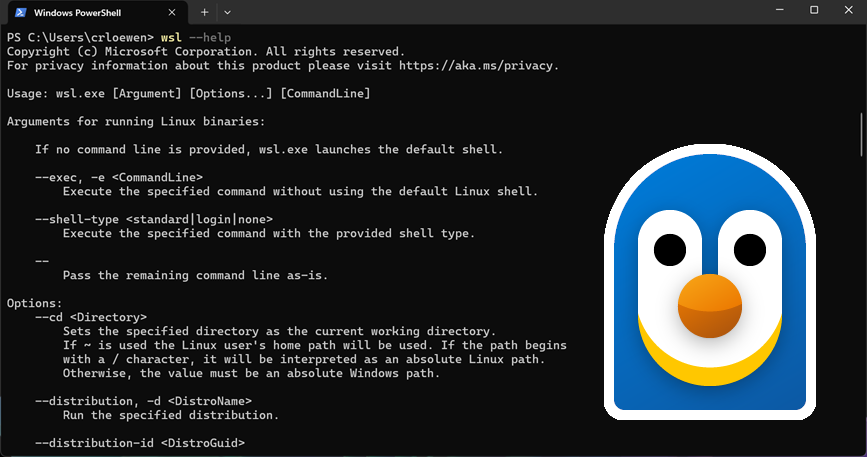I wish they’d open source the name.
It should be called the “Linux Subsystem for Windows”.
It’s so annoying, because both are technically grammatically correct, but the current one just sounds the opposite
Microsoft really has a knack for that. I also like
WoW64, which contains the binaries for running 32 bit applications on Windows 64 bit. For historical reasons, the 64 bit binaries live insystem32, obviously.Again, it is because it is part of a series.
They already had WoW (Windows on Windows) which was Win16 on Win32. The new one is Win32 on Win64.
And if say “Windows on Windows 64” it makes sense. It is Windows emulation on top of Windows 64 (64 bit Windows). When they named it, all Windows was 32 bit Windows and 64 bit Windows was the future thing. So “emulating current Windows on Win64” was what WoW64 was doing.
It did not age well though. I agree.
Yeah but it also shows the weird naming of WSL. It’s Windows (32) on Windows 64, but Windows Subsystem for Linux instead of Linux on Windows 64 (which would at least have fit the pattern).
There you can see that only drunks work at Microaoft.
I totally agree it is wrong. It is historical.
When Windows NT was new, they had this idea that it would be compatible with many different application ecosystems via “sub-systems”. So there were going to be many different “Windows sub-systems” for various things.
There was the “Windows sub-system for OS/2” for example. And the “Windows sub-system for POSIX”. The names still sound backwards to me but I guess it makes sense if you think “This is a Windows sub-system, which one is it?”. And if you have 50 Windows sub-systems, saying “for Windows” at the end of all of them also seems a little weird.
So that naming convention was already in place when they added support for Linux. Hence the “Windows Subsystem for Linux”.
This is actually due to trademark/copyright.
The first thing can’t be Linux due to that
However I agree.
No, Windows has various subsystems. This one is for Linux.
When Windows NT 3.5 launched, it came with subsystems for POSIX, OS/2, and Win32 because in the WinNT world even the Windows frameworks are a subsystem. Disclaimer: I didn’t check if in Win11 this is still the case but I guess so.
deleted by creator
It’s a subsystem of Windows
If I say “the life support system for the USS Enterprise”, nobody thinks that that’s a system running on the life support that gives you the USS Enterprise. It’s a system running on the USS Enterprise that gives you life support. Windows Subsystem for Linux sounds like it’s a system running on Linux that gives you access to Windows.
If I say “the life support system for the USS Enterprise”,
Unfortunately contact mean that example dose work both ways.
If we say enterprise system for life support. People will also understand.
But voyager system for enterprise could apply either way. To be fitted to enterprise or allow enterprise activity on voyager. Or voyager activity on enterprise. For is just bad language in this context.
Here Microsoft should’ve used a possessive. Voyagers enterprise support system would be more normal.
Or Windows Linux support system.
But marketing and a history of no other OS matters means Mickey$oft insists on it’s own layout. Over language clarity.
You say “The Windows Memory Subsystem” not “The Windows Subsystem for Memory”.
Windows Linux Subsystem would likely be most clear.
Does ‘Notepad subsystem for Linux’ sound to you like a Windows or Linux subsystem?
deleted by creator
deleted by creator
@randomcruft @fakeplastic I’m not real comfortable with my data on someone else’s computer, but triply so if that somebody is Microsoft, Gargoyle, or Amazon.
This depends entirely of what you mean by “of Windows” and what you mean by “for Linux”. This terminology is ambiguous.
Are you a Lemmy user for lemmy.world, or are you a lemmy.world user for Lemmy?
It’s also inconsistent because when they say, for example, “Microsoft Azure Linux Container Host for AKS”, they are talking about running a Microsoft Azure Linux Container inside of AKS, not a container that is meant to be used for running AKS within it…
It’s a Linux subsystem for Windows. As in, you run Windows and within it run Linux. Thus Linux is the sub-system, while Windows is the “overarching” system. Therefore, it’s Linux running as a subsystem on a Windows machine. Therefore, a Linux subsystem on/for Windows.
<edit>
That was just setting the two viewpoints equal.
Now, to add why this one is more “correct”: when talking about Windows (or Linux or anything else fir that matter) subsystems, you don’t call the Windows file system the Windows subsystem for Files or the Windows subsystem for Networking or Linux subsystem for RNG - You call them the filesystem, the networking system or the RNG system. And since none of them get the “for host” suffix, it seems natural to assume it’s the guest system that’s the “sub” system, with the other one being the whole.
</edit>
From the repo’s CONTRIBUTING.md:
Most contributions require you to agree to a Contributor License Agreement (CLA)
Meh, a permissive license + a copyright transfer means this shit is just a potential rugpull. MSFT can change the license of the project to source-available or even proprietary at any time and you’ll be powerless to stop it.
CLA is basically a requirement for any larger scale open source project. It would be mental to add a “this single edited line is licensed under X license” to every tiny commit. Microsoft’s CLA does not tranfer rights btw, it just licenses your contribution to M$ under “basically BSD 0 clause license” terms.
I guess sure they could do a ragpull but it does not make much sense. Reasons:
-
they have open sourced it themselves
-
It’s made by M$ for M$. They don’t have competition in the Windows space, so there is no point to hide the code.
Also what would be the worst thing that could happen if they did that? You would either use a fork, because WSL2 is basically feature complete at this points, or you would be have to use a proprietary app on a proprietary OS. Imo the licensing of WSL specifically is the least of Windows’ issues.
You absolutely do not need a CLA with a copyright transfer. There are plenty of large projects that use a Developer Certificate of Origin that protects the company while not allowing them to change the license of your contribution.
I’ll grant that my original post was pissy and angry and not a great take, however. You make good points here.
CLA and copyright assignment are different things. In some jurisdictions copyright assignment is impossible. That was among the clashes European FOSS contributors had with the Free Software Foundation and Richard Stallmann in the 1990s and 2000s.
Does the DCO really offer a real guarantee? it looks like it just adds a
Signed-off-by Johnline at the end of the commit, with no actual signature checking that enforces any particular version of a particular document is being acknowledged. IANAL but it doesn’t look like something proven to work in court to give legal protection.Sure, it’s easier to simply add a sign-off-by line than actually accepting a legal agreement, so it reduces the barrier of entry, but if this were really enough to establish the conditions to shift liability then I don’t see why companies wouldn’t start using their own DCOs and extending them, essentially just being a more convenient CLA (which is a license agreement, not a copyright transfer, even if some might add terms that allow relicensing… which anyway is already possible given the project is already MIT licensed).
-
You should still be able to fork, right? Under a non copyrighted name (see: firefox to icecat)
Yes.
There are two downsides if Microsoft takes it proprietary again in the future.
-
we would have to fork it and maintain the fork. Honestly, what kind of “community” are we if this is what we are complaining about?
-
Microsoft could include out contributions in their future commercial product.
Again, Microsoft cannot take away access to our own code. They just get to use it. That “freedom” really pisses some people off.
-
They can change future versions to that, not already released ones.
You’re correct, but I don’t believe that a company should be allowed to take my code and change its license in the future. If they want to take something proprietary, they can go ahead and remove my contribution from it first.
If you want to enforce that, you need to fork it and put a copyleft license on it. This is very rarely done because it’s more work to maintain software than to write it…
Hence my initial whinging about how this was released with a permissive license and a copyright transfer. The longer I’m involved in this industry, the less I like permissive software licensing. There’s obviously a place for it, but my tolerance for permissive licensing is directly tied to my trust for the person or organization backing the software. I don’t trust Microsoft, and I don’t think I will ever personally contribute to their software unless my contribution is made under a copyleft license and with a DCO, not a copyright-transferring CLA.
MIT license already allows this, with or without CLA.
That’s why you can also take Microsoft’s MIT code and make proprietary software out of it.
Sure. Let’s make sure that people know what this really means though.
Microsoft cannot “undo” the current license. If such a “rug pull” happens in the future, we all retain access to the code that exists at that time including all contributions from Microsoft. We can also all continue to not only use it but contribute to it under an Open Source license and keep it a vibrant, useful project if we want. Microsoft is powerless to stop us. We could fork it then or even now without the copyright assignment requirement. We have that freedom.
What the “rug pull” allows Microsoft to do is to decide, in the future, to change their policy and to make further changes themselves and not give us access to those future changes. They have that freedom.
Again, even if Microsoft did this, we could fork and carry-on. Look at Valkey and Reddis as an example.
So, the situation is that Microsoft is Open Sourcing a bunch of work that they did. The maximum possible downside is that they could stop giving us even more in the future. Our reaction is “meh”.
What concerns us is not that Microsoft can take away our freedom. They cannot. What upsets us is that they may retain or receive freedom we do not want them to have.
That is all fine. We are all allowed to think about it as we like and I guess we al value “freedom” in different ways. Sometimes though I think people misunderstand and think somehow that all the code could be “taken back”’. It cannot. Similarly, we might worry that our freedom (even the 4 freedoms) could be lost. For this code, that is not the case.
These are good points. I was in a shitty mood when I made my comment and upon reflection, it’s an overstatement and not a very good take. I do still strongly support copyleft licenses and DCOs over CLAs, but I shouldn’t turn my nose up when something is released without those.
I used to be excited when companies open-sourced stuff, and that is no longer the case. I suppose I’m just frustrated and bitter and cynical when it comes to large companies doing good things.
You sir, may be the highest quality person on the Internet.
We may disagree. One of us may be wrong. Or it may simply be two sides of the coin. Regardless, I respect your opinion and values and cannot begin to express how impressed I am with your response here. I hope someday to achieve the same level of maturity.
We cannot expect companies to be “good” but that is absolutely something we can strive for in ourselves.
Open source or not WSL is just a long game embrace, extend, extinguish and particularly designed to stop *NIX OSs gaining a foothold in the enterprise development space.
NGL, I spent a minute wondering why Microsoft would be going after NixOS in particular.
I am not defending Microsoft but I have a different take.
Microsoft has already lost a the enterprise to Linux. They know it but no longer care that much. This is because the real money is in Azure (the Cloud and “the agentic web”). Microsoft makes a tonne of money off Linux and Kubernetes in the cloud. They hope to make even more money off AI. They are ok that this stuff is all Linux based. They get plenty of lock-in from volume contracts and Azure only APIs and services (especially AI sandboxes ).
However, Microsoft knows the importance of developer mindshare and influence. It is still “developers, developers, developers”. They know they cannot really stop devs from using containers and Linux but they want devs using MS software. So, they are building Linux into the Windows desktop.
They hope, I believe, that the devs will prefer the “best of both worlds” Windows experience over the “all in on Linux only” Linux one.
In some ways, they are competing more with macOS. Devs using Linux on the server had been flocking to macOS on the desktop because it is “also UNIX” but with commercial software support and a nice UX. If Linux had won on the server, Microsoft is defending the Pro desktop.
deleted by creator
MIT license, for those wondering.
OSS or not, if its Windows I will take a shit on it
I guess it won’t be long before someone launches Windows 3.11 Subsystem for Linux.
That is WINE.
Wake me up when they open source windows…
Does it run wine? Does it run on wine? I need to recurse.
It does run WINE.
Embrace, extend, extinguish.
I would like to see Flatpak ported to Windows. WSL provides everything you need to support Flatpak including a Linux kernel to run on and deep GUI and network integration.
From the point of view of a user, a Flatpak app (built for Linux) could install and run natively on Windows. Flathub could be just neither App Store.
Small app developers could choose to target Flatpak instead of Win32 and have their app run on both Windows and Linux. Only one app bundle to distribute and support.
Thank of all the applications this could bring to Linux. And, once everything runs on Linux, why use Windows?
Now make windows run just for compatibility on a Linux Subsystem. How we actually need it in daily life…
That…is wine.
Windows makes wine?
No no of course not, but it’s a compatibility layer for windows inside linux.
Sounds like they’re basically abandoning it but at least giving the code out so the community can still use and keep it up until it becomes incompatible with Windows. It is one of the few ways I’m able to get my Windiws 11 work computer to do what I need with all the security and tracking junk my company installs on our laptops, even for developers, so I hope it sticks around for a while.
What exactly is a windows subsystem? Is it like VM?
Pretty much. It’s hyper-v under the hood giving you a linux VM that’s integrated just enough to keep up some sort of linux workflow. I’m happy to shit on it as much as the next person, but for many who are locked into a ms corporate ecosystem because work policy, it’s a decent little window in your jail cell.
So if I use a subsystem of linux in windows, then i wouldn’t risk losing data and it would be much more efficient than VM?
It’s not going to randomly disappear your data, but I don’t particularly trust it either. As with anything, keep to a back up strategy. As far as efficiency goes, if you bear in mind it is still a VM but with most of the configuration hidden away for a simpler experience, I would say it is more convenient than a VM under virtualbox or vmware player, especially if you have no need for a full linux desktop environment.













